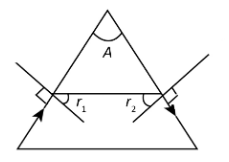Question
Question: The maximum value of refractive index of a material of prism which allows the passage of light throu...
The maximum value of refractive index of a material of prism which allows the passage of light through it when the angle of prism is A is:
A. 1+sin22A
B. 1+cos22A
C. 1+tan22A
D. 1+cot22A
Solution
For the maximum value of refractive index, the angle of incident is with respect to the surface of the prism and since there is only refraction of light takes place so there will not be total internal reflection and use Snell’s law and thermodynamic property.
Formula used:
According to the Snell’s law, the refractive index is given by μ=sinrsini
where, i is the angle of incident of light and r is the angle of refraction.
Complete step by step answer:
From the question, we know that the angle of the prism is A.Since there is only refraction of light and no total internal reflection. So,

r1=r2
We know that the angle of prism is equal to the sum of angle of refraction and the angle of emergence. Thus,
A=r1+r2
The above equation can be written as,
A=r1+r1 ⇒r1=2A
Now we using Snell’s law, the refractive index of the material of the prism will be,
μ=sinr1sini
Here, i is the angle of incident, which is equal to 90∘ as there is no total internal reflection.
μ=sin(2A)sin90∘ ⇒μ=sin2A1
Rewrite the above equation,
μ=sin22A1
Now we use the thermodynamic property, sin2A+cos2A=1
μ=sin22Asin22A+cos22A
After further simplifying the above equation, we have,
∴μ=1+cot22A
Thus, the maximum value of refractive index of a material of prism which allows the passage of light through it when the angle of prism is A is 1+cot22A.
Hence option D is correct.
Note: The relation between the refractive index and angle of minimum deviation is expressed as, μ=sin2Asin2A+δm
where δm is the minimum deviation and A is the angle of prism. In the case of minimum deviation, the angle of incidence is equal to the angle of emergence and symmetrical refraction takes place.
